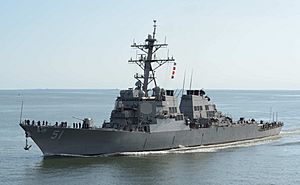Arleigh Burke-class destroyer facts for kids

USS Arleigh Burke in the Chesapeake Bay in 2013
|
|
Quick facts for kids Class overview |
|
|---|---|
| Name: | Arleigh Burke class |
| Builders: |
|
| Operators: | |
| Preceded by: |
|
| Succeeded by: | Zumwalt class |
| Cost: | US$1.843 billion per ship (DDG 114–116, FY2011/12) |
| Built: | 1988–present |
| In commission: | 1991–present |
| Planned: | 89 as of April 2020 |
| On order: | 3 |
| Building: | 6 |
| Completed: | 68 |
| Active: | 68 |
| Retired: | 0 |
| Preserved: | 0 |
| General characteristics | |
| Type | Guided missile destroyer |
| Displacement |
|
| Length |
|
| Beam | 66 ft (20 m) |
| Draft | 30.5 ft (9.3 m) |
| Installed power | 3 × Allison AG9140 Generators (2,500 kW (3,400 hp) each, 440 V) |
| Propulsion |
|
| Speed | In excess of 30 kn (56 km/h; 35 mph) |
| Range | 4,400 nmi (8,100 km) at 20 kn (37 km/h; 23 mph) |
| Boats & landing craft carried |
2 × rigid hull inflatable boats |
| Complement |
|
| Sensors and processing systems |
|
| Electronic warfare & decoys |
|
| Armament |
|
| Aircraft carried |
|
| Aviation facilities |
|
The Arleigh Burke class destroyers are powerful warships used by the United States Navy. These ships are named after Admiral Arleigh Burke, a famous American naval officer from World War II. The very first ship of this class, the USS Arleigh Burke, was even named while Admiral Burke was still alive!
These destroyers are like multi-talented superheroes of the sea. They can handle many different missions. They can launch Tomahawk missiles to hit targets on land. They are also great at defending against air attacks using their strong Aegis radar and special surface-to-air missiles. They can hunt down submarines and even protect against other ships. Some of these ships can even defend against antiballistic missiles.
The first ship of this class began service on July 4, 1991. The Arleigh Burke class has been built for a very long time. It is the longest-running production for any U.S. Navy surface combat ship since World War II.
Contents
What are Arleigh Burke Class Destroyers?
The Arleigh Burke class is a type of guided missile destroyer. These ships are built around a special system called the Aegis Combat System. This system includes a powerful SPY-1D radar. This radar helps the ships see far and track many targets at once.
Why are these ships important?
These destroyers are designed to do many jobs. They can:
- Launch Tomahawk missiles to hit targets on land.
- Defend against air attacks with powerful radar and surface-to-air missiles.
- Hunt for submarines using special sonar and rockets.
- Fight against other ships using Harpoon missiles.
- Some ships in this class can even shoot down antiballistic missiles.
Their design also helps them avoid being easily seen by enemy radar. This is called having a reduced radar cross-section.
How Big are These Ships?
The Arleigh Burke class destroyers are quite large. They are longer than a football field!
- Their length is about 505 to 509.5 feet (153.9 to 155.3 m).
- They weigh between 8,230 and 9,700 tons when fully loaded.
- They carry over 90 missiles.
These ships are bigger and have more weapons than many older ships that were called guided missile cruisers.
Key Features of the Arleigh Burke Class
These ships have different versions, called "Flights." Each Flight has some unique features.
Ship's Power and Speed
Arleigh Burke class destroyers are very fast.
- They use four General Electric LM2500 gas turbines for power.
- These engines give the ship a total of 105,000 bhp (78,000 kW).
- They can travel faster than 30 kn (56 km/h; 35 mph) (about 34 miles per hour).
- They can travel about 4,400 nmi (8,100 km) at a speed of 20 kn (37 km/h; 23 mph).
Weapons and Defense Systems
The destroyers are packed with various weapons:
- Guns: They have a large 5-inch (127 mm) gun on the front. They also have smaller 20 mm and 25 mm guns for closer defense.
- Missiles: They use a Vertical Launching System (VLS) to fire many types of missiles. These include:
- Tomahawk Land Attack Missiles for hitting land targets.
- Standard Missiles for air defense.
- Anti-Ballistic Missiles to intercept enemy missiles.
- ESSM for close-range air defense.
- Vertical Launch ASROC for anti-submarine warfare.
- Torpedoes: They carry torpedoes to attack submarines.
Aircraft on Board
- Earlier versions (Flight I and II) had a Flight deck for helicopters to land, but no hangar.
- Later versions (Flight IIA onwards) have a flight deck and enclosed hangars. These can hold up to two MH-60R Seahawk helicopters. These helicopters are used for hunting submarines and other tasks.
Images for kids
See also
 In Spanish: Clase Arleigh Burke para niños
In Spanish: Clase Arleigh Burke para niños








